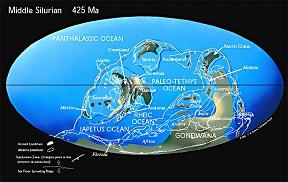Middle Silurian animals (Time series) - Wildlife in the Fossil sites
Classified animal and plant picture guide. Clicking the Organism name  shows the images, and pointing the Organism name
shows the images, and pointing the Organism name  shows the tooltip with three links at the left-top corner.
shows the tooltip with three links at the left-top corner.
 shows the images, and pointing the Organism name
shows the images, and pointing the Organism name  shows the tooltip with three links at the left-top corner.
shows the tooltip with three links at the left-top corner.The Middle Silurian in Paleozoic spanned from 428 to 423 millon years ago. The explanation in brackets is the ages they lived in extinct species. Note that Mya is million years ago. For example, "48.6~40.4 Mya" shows a range between 48.6 and 40.4 million years ago. The italic and bold figures, e.g. 488, show out of the range. The time range is shown in the Geological Time Table. The followings are a part of the Evolutionary Tree.
Silurian, Early Silurian, Middle Silurian、Late Silurian
The right map is the continents at Middle Silurian provided by C. R. Scotese PALEOMAP Project.
Silurian, Early Silurian, Middle Silurian、Late Silurian
The right map is the continents at Middle Silurian provided by C. R. Scotese PALEOMAP Project.

| 428.2 Mya | ||||
| 428.2~426.2 Mya | Jawless fish | Pharyngolepis  | ||
| 428.2~422.9 Mya | Trilobite | Tapinocalymene  | ||
| 428.2~421.3 Mya | Mollusc | Pilina | ||
| Trilobite | Didrepanon | |||
| 428.2~418.7 Mya | Sea bud | Troosticrinus | ||
| Jawless fish | Phlebolepis , Birkenia , Birkenia  , Ateleaspis , Ateleaspis  | |||
| 428.2~418.1 Mya | Sea scorpion | Mixopterus  | ||
| 428.2~412.3 Mya | Jawless fish | Cyathaspis  | ||
| 428.2~409.1 Mya | Trilobite | Apocalymene | ||
| Sea scorpion | Dolichopterus | |||
| 428.2~359.2 Mya | Coral | Disphyllum  | ||
| 428.2~0 Mya | Snail | (Pleurotomaria)  (Great Dying②③④⑤) (Great Dying②③④⑤) | ||
| 426.2 Mya | ||||
| 426.2~425.4 Mya | Trilobite | Contracheirurus | ||
| 426.2~422.9 Mya | Trilobite | Onycopyge  | ||
| 426.2~418.7 Mya | Jawless fish | Witaaspis , Tremataspis , Tremataspis  | ||
| 426.2~418.1 Mya | Sea bud | Pseudocrinites | ||
| Cystoid | Pseudocrinites | |||
| Jawless fish | Hemicyclaspis  | |||
| 426.2~412.3 Mya | Sea scorpion | Erieopterus | ||
| 426.2~383.7 Mya | First land plant fossil | |||
| Vascular plant | Cooksonia  (Primitive land plant) (Primitive land plant) | |||